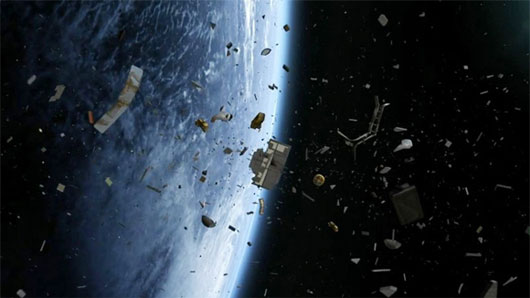Space waste - threat exists
The threat from cosmic garbage is increasing as more and more missile or satellite fragments fail or stop appearing in orbit near Earth. In the face of this situation, scientists are planning to clean up cosmic garbage to limit their impact on space research programs.
Accident outside the universe
In the morning of April 4, 2014 (in Vietnamese time), Europe's Sentinel-1A satellite was launched by Russian Soyuz-ST boosters from Kourou dance airport in French Guiana. About 20 minutes later, the Sentinel-1A satellite goes into orbit as expected. This is the first satellite under the multi-billion dollar environmental monitoring program Copernicus, implemented by the European Aeronautics Agency (ESA). According to ESA, the launch of the satellite marks the beginning of a new era in monitoring the Earth from space. But not yet happy, the European scientists face great worries. Only 34 hours after separating from the rocket, this $ 380 million satellite has nearly crashed into a stopped satellite by the US Aerospace Agency (NASA).
Also in early April 2014, NASA announced, the International Space Station (ISS) had to move about 800 meters further to avoid hitting some parts of the old Ariane 5 rocket. This is the second time in nearly 3 weeks that ISS has to move after a shift on March 16 to avoid colliding with an old Russian weather satellite. According to NASA, since it was launched in 1998, ISS has moved more than ten times to avoid space waste, in June 2012, the astronauts had to evacuate to the escape chamber of Soyuz when the garbage The universe flew near ISS.

Dense cosmic garbage surrounds the Earth.(Photo: Internet)
In May 2013, the Ecuadorian Space Agency (EXA) had to try to contact their only satellite after it stopped sending and receiving signals because it crashed into space. Pegasus satellite launched in China on April 25, but then hit a cloud of dust from an old rocket launched by the Soviet Union in 1985. According to EXA, solar panels The satellite has been damaged after the collision. Previously, in 1996, French satellites were also badly damaged after colliding with debris from missiles that were launched 10 years ago.
Massively littering
These are just a few of the many cases of the threat of cosmic garbage after decades of littering in orbit near Earth. NASA said that images of the Earth taken from the universe show that it is surrounded by a mess of waste, exists in parallel with the orbiting satellite.
Since Russia launched the first artificial satellite Sputnik 1 into orbit in 1957, so far, thousands of satellite launches have been made.
There are currently about 6,000 artificial satellites orbiting the Earth, in which the United States is the country with the largest number of satellites. There are 400 satellites flying out of its orbit and many satellites are no longer active, contacting them is also completely lost. The satellites are no longer working, along with pieces of equipment taken up in space refueling, becoming cosmic waste and surrounding the Earth. According to NASA, more than 500,000 pieces of cosmic trash are wandering indefinitely in Earth orbit, which currently has more than 17,000 objects larger than a cup of coffee, threatening activities in space. Because the speed of movement in the universe is very large, so even a 1cm-size nut can cause a collision with force equivalent to a hand grenade. NASA said that these cosmic waste creates a potential threat to human and property in space as well as on Earth.
Use lasers to clean up space garbage
Scientists in many countries are discussing solutions to prevent and reduce the consequences of cosmic garbage. Recently, researchers at the Australian National University (ANU) received a $ 20 million grant from the government along with $ 40 million invested by the private sector to invest in a laser device research project. Shoot from Earth to blow away thousands of tons of cosmic waste surrounding our planet. The goal is to destroy about 300,000 tons of space waste within 10 years.
The proliferation of cosmic trash also caused Japanese scientists to test a sort of cosmic garbage grid to limit their influence on space research programs. Accordingly, when entering orbit, satellites will throw the net into the space garbage. The grid of electricity slows the movement of garbage until it is harmlessly burned in the Earth's atmosphere. As a result, it can limit the influence of cosmic waste fragments that could endanger human satellites, spacecraft, or space research programs.
- Recycle space waste, impossible thought possible!
- Space waste has doubled in the last 10 years
- CO2 gas accumulates a lot of waste in space
- Space waste - where do they come from?
- Why can't trash be dumped into space?
- Russia built a shield capable of crushing cosmic waste
- The waste of visitors pollutes the 'Roof of the world'
- Hazardous waste can cause bisexual syndrome in polar bears
- Method to turn astronaut waste into food
- Develop a code of conduct on space
- Can objects that fall into Vietnam be 'space bridge'?
- The threat from the US nuclear waste warehouse left the Arctic ice
 Van Allen's belt and evidence that the Apollo 11 mission to the Moon was myth
Van Allen's belt and evidence that the Apollo 11 mission to the Moon was myth The levels of civilization in the universe (Kardashev scale)
The levels of civilization in the universe (Kardashev scale) Today Mars, the sun and the Earth are aligned
Today Mars, the sun and the Earth are aligned The Amazon owner announced a secret plan to build a space base for thousands of people
The Amazon owner announced a secret plan to build a space base for thousands of people